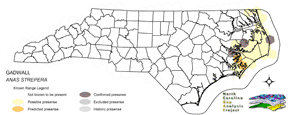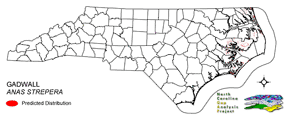
| Taxa: |
| Order: |
| Family: |
| Aves |
| Anseriformes |
| Anatidae |
| NatureServe Global Rank: |
| NatureServe State (NC) Rank: |
| G5 |
| S2B,S4N |
| Federal Status: |
| NC State Status: |
| --- |
| --- |


| Land Unit |
| US Fish & Wildlife Service |
| US Forest Service |
| US National Park Service |
| US Department of Defense |
| NC State Parks |
| NC University System |
| NC Wildlife Res. Com. |
| NC Forest Service |
| NC Div. of Coastal Mgmt. |
| Local Governments |
| Non-Governmental Org. |
| Other Public Lands |
| Private Lands |
| GAP Status 1-2 |
| All Protected Lands |
| Statewide |
| Hectares |
| 11,535.75 |
| 47.61 |
| 3,015.45 |
| 6,348.78 |
| 69.48 |
| 0.00 |
| 2,574.63 |
| 0.00 |
| 546.12 |
| 1.71 |
| 617.76 |
| 21.87 |
| 51,418.89 |
| 18,837.90 |
| 24,779.16 |
| 76,198.05 |
| Acres |
| 28,505.45 |
| 117.65 |
| 7,451.34 |
| 15,688.17 |
| 171.69 |
| 0.00 |
| 6,362.05 |
| 0.00 |
| 1,349.49 |
| 4.23 |
| 1,526.52 |
| 54.04 |
| 127,058.82 |
| 46,549.46 |
| 61,230.63 |
| 188,289.45 |
| % of Dist. on |
| Prot. Lands |
| 46.6 % |
| 0.2 % |
| 12.2 % |
| 25.6 % |
| 0.3 % |
| 0.0 % |
| 10.4 % |
| 0.0 % |
| 2.2 % |
| 2.5 % |
| 2.5 % |
| < 0.1 % |
| 0.0 % |
| 76.0 % |
| ----- |
| ----- |
| % of Dist. on |
| All Lands |
| 15.1 % |
| < 0.1 % |
| 4.0 % |
| 8.3 % |
| < 0.1 % |
| 0.0 % |
| 3.4 % |
| 0.0 % |
| 0.7 % |
| < 0.1 % |
| 0.8 % |
| < 0.1 % |
| 67.5 % |
| 24.7 % |
| ----- |
| ----- |
|
Nests on Pea Island (Potter et al. 1980) and is fairly common on the barrier islands from Cedar Island north; uncommon to occasional in the rest of the coastal area (Fussell 1994), absent during the summer from the rest of the state (Potter et al. 1980, Simpson 1992). Cedar Island may be the southern breeding limit for the species (Fussell 1994). Usually associated with fresh or brackish water, feeding in sloughs, ponds, lakeshore marshes to open salt bays and estuaries (Pearson 1959). Often nests on islands (Harrison 1975). In North Carolina, found to nest on small islands in impoundments at Pea Island, on islands of dredged debris in the Oregon Inlet (Potter et al. 1980), around the edges of ponds on Bodie Island (Fussell 1994). Will also nest in meadows (Harrison 1975). Nest is placed on dry ground among tall reeds or dense grasses (Harrison 1975), usually near water (Bellrose 1976). NATURE SERVE GLOBAL HABITAT COMMENTS: Lakes, ponds, rivers, marshes. Prefers freshwater but may be found on any open water during migration and winter. Moderate- to large-sized wetland of a permanent or semipermanent nature, expanses of open water with submersed vegetation, and open undisturbed shorelines are important molting habitats (Ringelman 1990). Nests in thick vegetation near freshwater lakes, ponds, or streams, including open brackish or alkaline waters. Nests usually in dry upland site under clump of shrubs or in herbaceous vegetation, average of 300 m from water. Tends to nest near semipermanent wetlands that are relatively resistant to drought (Ringelman 1990). Commonly uses man-made ponds. May nest on island, upland meadow or grassland. Suitable nesting islands should be 0.1-0.5 ha in size, elongate, and separated from mainland by at least 150 m of water that remains 0.9 m deep in nesting season (Ringelman 1990). Successful breeders usually return to nesting area used the previous year (Szymczak and Rexstad 1991). A diversity of wetland types is required for successful reproduction, so that brood-rearing habitat is near nesting habitat; females will move brood up to 1.9 km to brood habitat (Ringelman 1990). |
| Code | Name | Description | NC Natural Heritage Program Equivalent |
| 3 | Tidal Marsh | Fresh and brackish tidal marshes, including cord grass, wild rice, sawgrass and needlerush alliances. | Brackish Marsh, Interdune pond, Maritime wet grassland |
| 124 | Maritime Scrubs and Tidal Shrublands | Coastal shrubs including wax-myrtle, swamp rose, alder, yaupon, and greenbriar. | Maritime Shrubs, Salt Shrub |
| 372 | Interdune Herbaceous Wetlands | Dune swales with permanently flooded to intermittently exposed hydrology. Species composition depends on salinity and can include cut grass, spike-rush, mosquito fern, and hornwort. | Interdune Pond, Maritime Wet Grasslands |
| 371 | Maritime Grasslands | Dune grass community consisting of sea oats and beach grasses. | Dune grass, Maritime dry grassland |
| 380 | Coastal Plain Fresh Water Emergent | Emergent vegetation in fresh water seepage bogs, ponds and riverbeds of the coastal plain. Includes alliances dominated by sedges, eelgrass, as well as cane found in unforested cane-brakes. | Small Depression Pond, Sandhill Seep, Floodplain Pool, Unforested Floodplain Canebrake, Riverscour Prairies, Vernal Pools |
| 173 | Coastal Plain Riverbank Shrubs | Shrub dominated riverbanks, commonly dominated by willows and/or alders. | Sand and Mud Bar |
| 205 | Agricultural Pasture/Hay and Natural Herbaceous | Farm fields used for pasture grass or hay production, as well as old fields dominated by native and exotic grasses. | No equivalent |
| 8 | Open water | Open water without aquatic vegetation. | No equivalent |
|
Ringelman, J. K. 1990. Life history traits and management of the gadwall. U.S. Fish & Wildl. Serv., Fish and Wildlife Leaflet 13.1.2. 6 pp.
Simpson MB Jr. 1992. Birds of the Blue Ridge Mountains. Chapel Hill and London: University of North Carolina Press. Fussell, J.O. III. 1994. A birder’s guide to coastal North Carolina. Chapel Hill and London: The University of North Carolina Press. Barker, W. T., et al. 1990. Effects of specialized grazing systems on waterfowl production in southcentral North Dakota. Trans. 55th North American Wildl. & Nat. Res. Conf., pp. 462-474. Pearson, T.G. 1959. Birds of North Carolina. Raleigh, NC: Bynum Printing Company. Harrison, H.H. 1975. A field guide to bird's nests in the U.S. east of the Mississippi River. Houghton Mifflin Company, Boston, Massachusetts. 257 p. Bellrose, F.C. 1976. Ducks, geese and swans of NorthšAmerica. Stackpole Books, Harrisburg, Pa. Harrison, C. 1978. A field guide to the nests, eggs and nestlings of North American birds. Collins, Cleveland, Ohio. Potter, E. F., J. F. Parnell, and R. P. Teulings. 1980. Birds of the Carolinas. Univ. North Carolina Press, Chapel Hill. 408 pp. Terres, J.K. 1980. The Audubon Society encyclopedia of North American birds. Alfred A. Knopf, New York. American Ornithologists' Union (AOU), Committee on Classification and Nomenclature. 1983. Check-list of North American Birds. Sixth Edition. American Ornithologists' Union, Allen Press, Inc., Lawrence, Kansas. Marcy, L. E. 1986. Waterfowl nest baskets. Section 5.1.3, US Army Corps of Engineers Wildlife Resources Management Manual. Tech. Rep. EL-86-15. Waterways Expt. Station, Vicksburg, Mississippi. 16 pp. Root, T. 1988. Atlas of wintering North American birds:An analysis of Christmas Bird Count data. University of Chicago Press. 336 pp. Droege, S., and J.R. Sauer. 1990. North American Breeding Bird Survey, annual summary, 1989. U.S. Fish and Wildlife Service, Biological Report 90(8). 22 pp. Livezey, B. C. 1991. A phylogenetic analysis and classification of recent dabbling ducks (tribe Anatini) based on comparative morphology. Auk 108:471-507. Szymczak, M. R., and E. A. Rexstad. 1991. Harvest distribution and survival of a gadwall population. J. Wildl. Manage. 55:592-600. |
For more information please contact them at:
NC-GAP Analysis Project
Dept. of Zoology, NCSU
Campus Box 7617
Raleigh, NC 27695-7617
(919) 513-2853
www.basic.ncsu.edu/ncgap